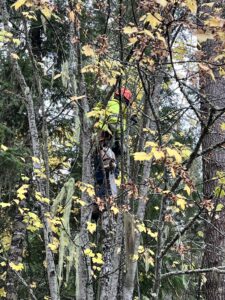Tree Pruning
The Art and Science of Tree Pruning
Tree pruning, often considered both an art and a science, is a vital practice in arboriculture aimed at enhancing the health, aesthetics, and safety of trees. Whether in urban landscapes, suburban gardens, or vast forests, proper pruning can significantly impact a tree's growth and longevity.

Why Prune Trees?
1. Health Enhancement: Pruning promotes the overall health of trees by removing dead, diseased, or dying branches. These can serve as entry points for pests and diseases, compromising the tree's vitality.
2. Structural Integrity: By selectively removing branches, arborists can improve a tree's structure and reduce the risk of branches breaking during storms or under their own weight. This is particularly important for older or larger trees.
3. Aesthetic Appeal: Pruning enhances the tree's natural shape and appearance, making it more visually pleasing and fitting within its environment. Properly pruned trees also have improved light penetration and air circulation through their canopy.
4. Safety Considerations: Removing hazardous branches prevents potential accidents, such as falling limbs that could injure people or damage property.
Benefits of Tree Pruning
- Health Improvement: Pruning helps remove dead or diseased branches, promoting overall tree health by reducing the risk of insect infestations and diseases.
- Aesthetic Appeal: It enhances the tree's appearance by shaping it, promoting balanced growth, and improving its overall structure.
- Safety: Regular pruning removes hazardous branches that could fall and cause damage during storms or high winds, making the surroundings safer.
- Fruit Production: Fruit trees benefit from pruning as it encourages fruit production by allowing more sunlight and airflow into the canopy.
- Young Tree Development: Proper pruning of young trees helps establish a strong structure and shape early on, leading to healthier growth as they mature.
- Property Protection: By keeping branches away from structures like homes, power lines, and fences, pruning reduces potential damage from falling limbs.
Each of these benefits contributes to the longevity and vitality of trees, making pruning an essential part of tree care and maintenance.
The Perfect Time to Prune Trees
The ideal time to prune trees can depend on the specific type of tree and your goals for pruning. However, here are some general guidelines:
- Winter Dormancy (Late Winter/Early Spring): This is often considered the best time for most tree pruning. The tree is dormant, which reduces stress, and you can easily see the tree's structure without leaves.
- Summer Pruning: For certain trees, especially those that bloom in spring, pruning immediately after flowering can help promote new growth and maintain their shape.
- Avoiding Hazardous Seasons: It's generally best to avoid pruning during seasons of active growth (spring and summer for most trees) to minimize stress and avoid excessive sap loss.
- Dead or Diseased Limbs: These can be pruned any time of year to prevent further damage to the tree.
The timing can vary based on your location and the specific tree species, so it's often beneficial to consult with a local arborist or tree service for the best advice tailored to your area and tree type.
For free estimates and assessments:
NORTHERN LAKES TREE SERVICES
Damon Bretthauer
Phone: (208) 443-3600
Cell: (208) 610-3718
Locations:
- North Idaho: Priest Lake, Priest River, Oldtown, Sandpoint, Ponderay, Bonners Ferry, Cocalalla, Diamond Lake, Sacheen Lake, Rathdrum, Spirit Lake, Twin Lakes,Couer d’Alene, and the Hayden Lake area
- Eastern Washington: Newport, Deer Park, Elk, Spokane County, and Spokane Area
- Northern Lakes Area
